Photos - personal archive of Diana Dimitrova and Ministry of Culture of Greece
Maria S. Topalova
The excavations in Amphipolis continue at a rapid pace and archaeologists are currently preparing the site for the winter, protecting it from the vagaries of weather. Everyone is holding their breath in anticipation of the new revelations about the deceased person to whom the impressive tomb belongs. Whatever his name, he was a very influential person in the ancient Macedonian state. A very important neighbour of the Macedonians who lived at the time to which the tomb in Amphipolis dates back was Odrysian king Seuthes III. 2014 marks the 10th anniversary of the discovery of the tomb of the ruler who was a difficult neighbour to the north and a rival of the successors to Alexander the Great. 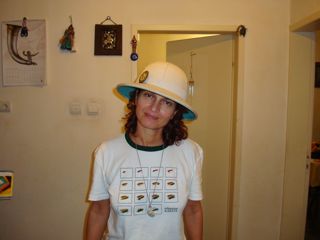 GRReporter contacted archaeologist Diana Dimitrova, a member of the research team led by Dr. Georgi Kitov that discovered the tomb of Seuthes III. We asked her to take us back to the centuries of that legendary rivalry that surely has been transferred to the tombs of the rulers.
GRReporter contacted archaeologist Diana Dimitrova, a member of the research team led by Dr. Georgi Kitov that discovered the tomb of Seuthes III. We asked her to take us back to the centuries of that legendary rivalry that surely has been transferred to the tombs of the rulers.
- Mrs. Dimitrova, what distinguishes the style of the tomb of Seuthes III and the Thracian tombs in general from those in the ancient Macedonian state, including the one in Amphipolis that dates back to the same historical period, namely the second half of the 4th century BC?
- The tomb in Amphipolis is not yet completely explored but what is seen on the Internet shows that it has a semi-cylindrical vault, similar to the vault of the tombs in the ancient Macedonian state whereas the first chamber of Golyamata Kosmatka (the tomb of Seuthes III) has a cantilevered arched vault, which is a transition between the flat roof and the arched roof but before achieving the perfect semi-cylindrical shape that we see in Amphipolis, at least in the photos on the Internet. The second chamber of Golyamata Kosmatka, the round one, has a dome-shaped roof. This form is known from Mycenae and Thrace. I mean the wider Thracian land, not only today’s Bulgaria but also northwestern Turkey, northwestern Asia Minor - every place where the Thracian tribes had settled. There are quite a few differences but it is still early to draw analogies between Amphipolis and Golyamata Kosmatka. In all cases, the architecture is different and probably the grave in Amphipolis does not belong to just anybody.
In my personal opinion, based on the information that is available on the Internet, the facility in Amphipolis is not in a mound but in a natural hill. The terrain there consists of sandy rocks and it is easy to dig in it. I think the huge hill that we see is natural and the facility was excavated in it; it is not a mound piled up by human activity. This is my subjective opinion based on what I see in the media but 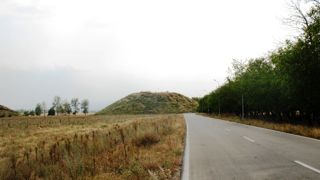 the colleagues will specify this more accurately. This is another difference from Golyamata Kosmatka that is a huge mound, the work of human activity. It is a huge hill, erected in the plain, at the foot of the mountain, but it was purposefully piled up and part of the embankment was removed afterwards, when the first part of the facility had to be built. We have documented this very clearly, based on the slope of the layers that fall to the facility itself. Therefore, I think this is one difference, but we will have more information once the excavations are completed.
the colleagues will specify this more accurately. This is another difference from Golyamata Kosmatka that is a huge mound, the work of human activity. It is a huge hill, erected in the plain, at the foot of the mountain, but it was purposefully piled up and part of the embankment was removed afterwards, when the first part of the facility had to be built. We have documented this very clearly, based on the slope of the layers that fall to the facility itself. Therefore, I think this is one difference, but we will have more information once the excavations are completed.
- Could you remind us of the tomb of Seuthes III, its architecture, size, the artefacts found in it?
- It is my pleasure to recall, 10 years after its discovery, the colossal event that has not yet been surpassed and I do not know if this will ever happen in the Thracian and Bulgarian lands in the coming years. The mound itself is very large. It is one of the most prominent in the Valley of the Thracian Kings, in particular at the foot of Stara Planina at Shipka, between Shipka and Kazanluk. A unique facility under the mound was found in it in 2004 consisting of an alley, facade before a 13-metre long corridor, three chambers, the latter being cut in the form of sarcophagus from a single stone block that probably weighs about 60 tons. This chamber has a cover that also weighs about 30 tons and resembles a gable roof. The facility was built in the early 4th century BC and the Thracian Odrysian aristocracy used it as a temple for a long time. Odrysian king Seuthes III was symbolically buried in it at the end of the 4th century BCand at the beginning of the 3rd century BC. Symbolically, because no bones were found in the third sarcophagus chamber. However, there were burial gifts and his name was inscribed on three of them. The name ‘Seuthes’ was written in genitive on the bronze helmet, on the metope, which means that it was his personal property. It was used by the king himself and when they had to perform this symbolic burial, it was in the capital city of Seuthopolis, which is why they put the used helmet there, not because they were not able to put a parade helmet.
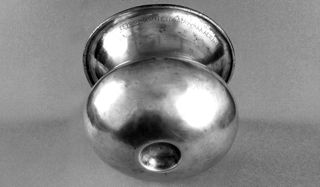 The name of Seuthes was also written on a silver phial, kylix type, and its weight was indicated in Alexander the Great tetradrachms. The same was written on the handle of a silver jug - the name of Seuthes and its weight in Alexander the Great silver tetradrachms. The wreath of the Thracian king, which was previously rumpled, was put on the bed, its leaves being scattered not only all over the third chamber. We found fragments of leaves in amphorae, we found a whole leaf and fragments of two other leaves carefully arranged between two rough stones built in the wall of the corridor.
The name of Seuthes was also written on a silver phial, kylix type, and its weight was indicated in Alexander the Great tetradrachms. The same was written on the handle of a silver jug - the name of Seuthes and its weight in Alexander the Great silver tetradrachms. The wreath of the Thracian king, which was previously rumpled, was put on the bed, its leaves being scattered not only all over the third chamber. We found fragments of leaves in amphorae, we found a whole leaf and fragments of two other leaves carefully arranged between two rough stones built in the wall of the corridor.

This means that the wreath, at least at the time of the construction of the facade and the south end of the corridor, had already been put inside the chamber. We are still exploring and asking, and trying to answer, the question as to what was the sequence of construction of the facility, its use, and the extension of the corridor. Obviously, at first the structure consisted of only that part of the unit, which was built of finely cut stone blocks, namely of the three chambers - rectangular, round and sarcophagus, and a very well constructed facade without decoration. This was the entire facility.
The corridor was built afterwards, it is possible that its south end and the facade be built after the 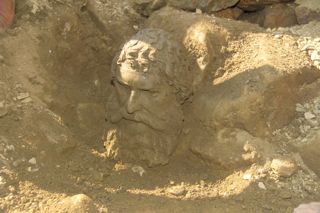 rituals themselves and the placement of the burial gifts inside the third chamber. However, it happened shortly after putting the gifts and the wreath inside. Once all these rituals had been performed, a bronze head from a statue of the Thracian king himself was placed at a distance of 7 metres in front of the facade, on the alley that was carefully separated with pebbles. We think this is a portrait of the Thracian king Seuthes III, which we established based on images on his coins. The profile of the head and the profiles on the coins are very much identical and similar. Probably the statue was placed somewhere in the capital city of Seuthopolis and it is a unique work of ancient art. It was probably made between 325-320 BC by Greek sculptor Silanion. This is the hypothesis of an Italian art expert, Paolo Moreno, and other researchers, including its discoverer Georgi Kitov, agree with it too. Probably it was made by him or it was made in is his studio. This is indicative of the extraordinary economic power of Thracian king Seuthes III and of his prestige, because he was able to order such an expensive work of art.
rituals themselves and the placement of the burial gifts inside the third chamber. However, it happened shortly after putting the gifts and the wreath inside. Once all these rituals had been performed, a bronze head from a statue of the Thracian king himself was placed at a distance of 7 metres in front of the facade, on the alley that was carefully separated with pebbles. We think this is a portrait of the Thracian king Seuthes III, which we established based on images on his coins. The profile of the head and the profiles on the coins are very much identical and similar. Probably the statue was placed somewhere in the capital city of Seuthopolis and it is a unique work of ancient art. It was probably made between 325-320 BC by Greek sculptor Silanion. This is the hypothesis of an Italian art expert, Paolo Moreno, and other researchers, including its discoverer Georgi Kitov, agree with it too. Probably it was made by him or it was made in is his studio. This is indicative of the extraordinary economic power of Thracian king Seuthes III and of his prestige, because he was able to order such an expensive work of art.
- Could you take us back in history and remind us of the relations of Seuthes III with the Macedonian kings?
- Their relationships were quite complicated. He had to survive, to protect his territory in a complex situation after the death of Alexander the Great, when his successors divided the great Macedonian state between themselves. Lysimachus, the successor to Alexander the Great in Thrace, had appetites to bring the whole territory under his control and Seuthes III had to comply with some diplomatic relations but also to "grit his teeth" sometimes, if I could put it in a more popular way. He was defending his territory, although in the last quarter of the 4th century BC the Odrysian kingdom was much smaller than in the early 4th century BC, at the time of Cotys I. Seuthes III was defending his territories. Sometimes he entered in alliance with Lysimachus, but sometimes with the Greek cities on the Thracian coast, including Amphipolis. He allied with them against Lysimachus not because he was such by nature but because he had to defend the interests of his country and its people. If he was not flexible, did not comply with the circumstances and did not enter in alliance with those who were powerful he had no chance of surviving. Therefore, the relations with Lysimachus were complex, they were not straight and smooth and sometimes he had to fight with him.
- As for the tomb in Amphipolis, there are still doubts that it may have been visited by treasure hunters. Did you have such doubts about Golyamata Kosmatka? How do you think archaeological sites can be protected from treasure hunters?
- Golyamata Kosmatka was defiled by neither modern nor ancient treasure hunters. However, this is an exception. As for Amphipolis, it is seen that either modern or ancient treasure hunters have taken some of the gifts but because the excavations are not yet finished I would not like to comment on them. The issue is that the state must apply very strict sanctions against treasure hunters. It is not enough to have them in a law. We have a law. The point is that they should be applied in order for treasure hunters to know that they cannot ruin the national and global wealth unpunished. This is because neither Amphipolis belongs to the Greeks alone nor Golyamata Kosmatka belongs to the Bulgarians alone. These are monuments of world importance and I am fascinated by the Greek state that has quickly assumed possession of its property.
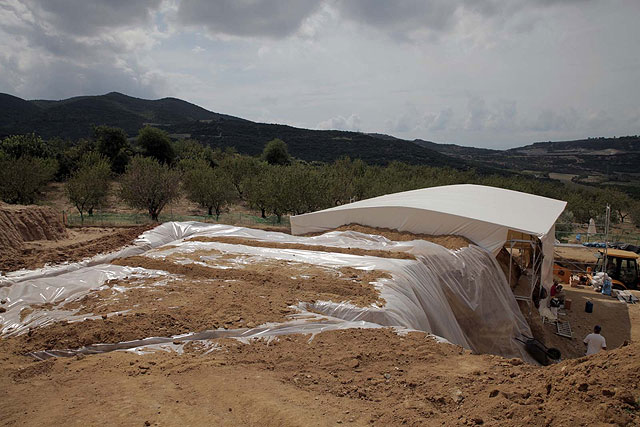
A beautiful shed has been built there. Yes, it slightly spoils the look of the facility itself, it is better to take photographs without the shelter, but it will protect it from the weather, at least at first. Moreover, it is nice and beautiful, although it was built quickly. This is something we build alone in Bulgaria, upon finding such facilities we put above some structure to protect them. Obviously, the Greek state very firmly and steadily supports archaeology. Something I would like to happen in Bulgaria too.
- By the way, in the middle of August the site was put under a 24-hour police protection. No one can enter it just like that. The Greek Prime Minister went to the site to be informed of the excavations and the requirements of scientists. The information that reaches the media is very regular and highly channelled. The pictures are official, they are taken by archaeologists who are on site and published every two-three days on the site of the Greek Ministry of Culture. The same applies to the information on the progress of the excavations.
- I congratulate the Greek state and the Greek colleagues for putting things in order, which is very difficult. You cannot imagine how hard it is to do your job when people come to you in half an hour saying, "Tell me now for this issue." Of course, without journalists, no one will be aware of our work but an archaeologist cannot do his or her job if subject to such media attention. I congratulate the Greek state for this order because it allows archaeologists to professionally do their job and obtain the most information from the site they have the chance to explore. I hope that later, once its exploration has been completed, we will be able to visit it too, as tourists, of course. I wish my colleagues from the bottom of my heart and soul that the last chamber is not robbed.
- What are you personally currently working on?
- Over the past three months I have been trying to finish a book about Golyamata Kosmatka on occasion of the 10th anniversary of the discovery of this magnificent monument. I am almost at the finish. It was fantastic, as it happened in the course of regular archaeological excavations. Unfortunately, Dr. Kitov passed away quite suddenly and he could not publish it. I am saying that I am trying to finish it because I am involved in the excavations of a mound near the Serbian border and I am in the field. This mound falls within the gas pipeline project between Bulgaria and Serbia and the  excavation works are very urgent. I think the 10th anniversary of the discovery of the tomb of Seuthes III is a good reason to tell your readers that in 2009, six months after Dr. Kitov passed away, an entrepreneurial committee of archaeologists, public figures, journalists undertook to make a monument of Georgi Kitov in Sofia. The plot is already granted, the monument is ready as a project, and the bas-relief is ready and approved. We are awaiting a final approval from the Ministry of Culture, from a special board for plastic arts. We need some more funds for the construction itself. Most of the stone on which the bas-relief will be mounted is paid but we need about 2,000 leva for the finishing works. If someone wants to help, he or she can donate to the following bank account:
excavation works are very urgent. I think the 10th anniversary of the discovery of the tomb of Seuthes III is a good reason to tell your readers that in 2009, six months after Dr. Kitov passed away, an entrepreneurial committee of archaeologists, public figures, journalists undertook to make a monument of Georgi Kitov in Sofia. The plot is already granted, the monument is ready as a project, and the bas-relief is ready and approved. We are awaiting a final approval from the Ministry of Culture, from a special board for plastic arts. We need some more funds for the construction itself. Most of the stone on which the bas-relief will be mounted is paid but we need about 2,000 leva for the finishing works. If someone wants to help, he or she can donate to the following bank account:
Fundraising bank account for building a monument to Georgi Kitov held by the TEMP (Thracian expedition for mound studies) in
Banka DSK - klon Batenberg
IBAN: BG46STSA93000019051808
BIC: STSABGSF
As everything is settled through the bank the donors are known and their names will be published in a small booklet that we will issue to recall the merits of Georgi Kitov for the Bulgarian archaeology. Golyamata Kosmatka is one of his impressive discoveries but it is far from being the only one in his 42-year professional career. The names of people who have donated 10 or 20 leva will also be included in the brochure that we will circulate as much as possible, as this is support too and it is from the heart.